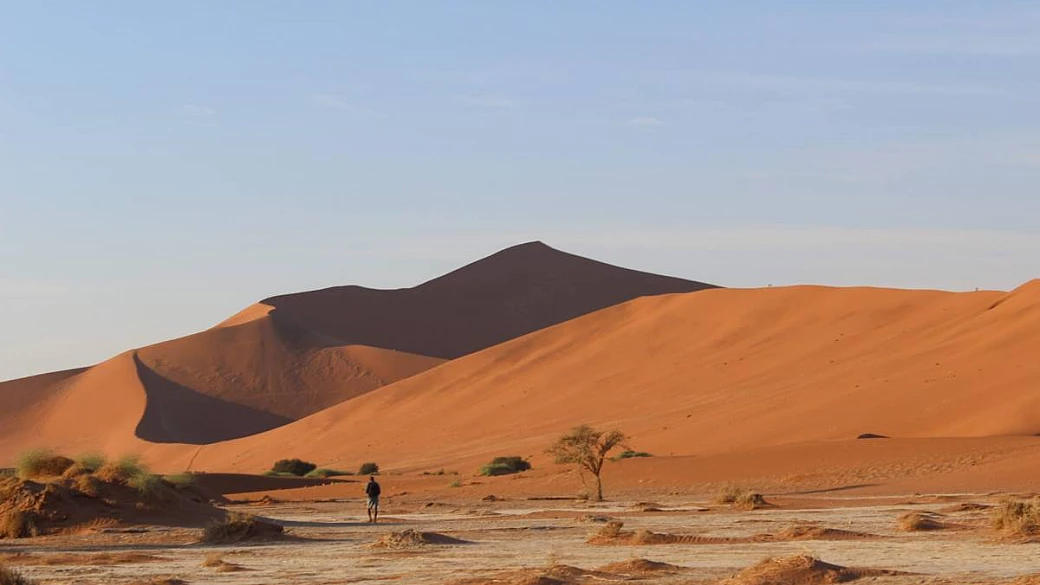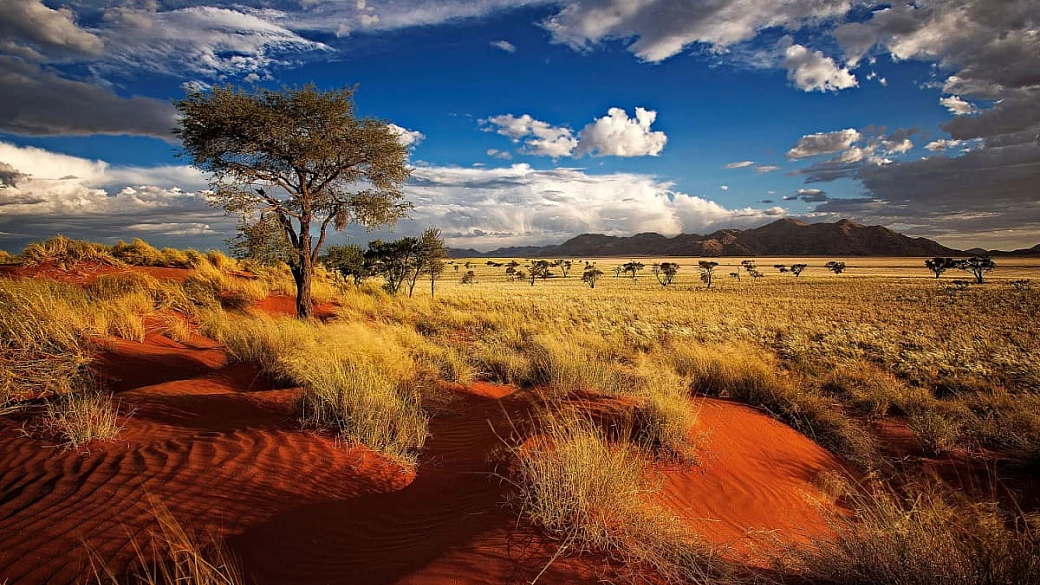Combination of Namibian highlights with diverse cu

We drove 4.800 kms and the majority of them are gravel roads even if in good conditions.
We went to visit remote villages and primary school where we left clothes and gifts for kids.
This is the best way to know them and make them happy. They are all very poor but they seem to be happy. This is the main difference with South America.
Africa is a great experience!!!!! Namibia is the best place I’ve ever seen in my life!!! This journey displays a combination of the touristy highlights of Namibia and its diverse cultures. The rich variety of cultures each has their own distinct values and traditions, and render a unique character to the profile of Namibian society. Day 1: Arrival at Windhoek International Airport met and greet by our representative. Transferred to the hotel, where you go over your itinerary with the representative – receipt of rental car. Nested between the edge of vast Namibian wilderness pulsating capital of Namibia, Windhoek lies a hotel adventure like no other. Step into the glow of unrivalled Namibian hospitality at Safari hotel. Enjoy lunch at the hotel and get picked up in the afternoon for a Katutura by night experience combined with a township tour. The township tour gives visitors the opportunity to learn about the history, development and people of Katutura. The sprawling suburb on Windhoek’s northern outskirts some 10 km from the CBD was established in 1950’s as a result of South Africa’s apartheid policy of divide and rule. Today Katutura is a crowded suburb where people from different cultures live together in peace and harmony. From iron shacks to up-market houses, it is a diverse, lively and historical place to visit. The Katutura by night experience is filled with traditional dancing and African food. The venue is a meeting place for local Namibians from all walks of life. You will be sitting around a fire and enjoy your dinner whilst taken in the cultural experience. Namibian craft and paintings will be at display for sale. This experience will provide an enlightening, positive and entertaining experience to the client with a deeper understanding of the Namibian cultures. Day 2: After breakfast depart from Windhoek. The route leads southwards to Blässkranz Guest Farm which lies along the northern reaches of the Naukluft. In the otherwise relatively inaccessible Naukluft, a valley of several kilometers in length was formed. It is in this valley that one will find the farmhouse. Surrounded by precipitous crags almost 2,000 m in height, Blässkranz is an ideal point of departure for mountaineer and hiker alike. This is the prime habitat for mountain zebra, kudu and leopard. Another very rewarding excursion is the Märker Cave, which was used by Bushmen in earlier times.
Day 3: After breakfast, the tour proceeds further south towards the famous dunes of Sossusvlei. Lunch, dinner, bed and breakfast at Betesda Lodge. In the heart of the Namib Desert there is a place where time does not exist. A world of colour, awe-inspiring plains, surrounded by magnificent mountains, you can experience tranquility, silence and solitude. Drive into the famous Sossusvlei boasting the highest dunes in the world. The dramatic colours, enhanced by the setting sun will be experienced. Day 4: Continue through the Kuiseb Canyon and across the Namib Desert to the Atlantic Coast. Along the way the ancient Welwitschia mirabilis desert plant and moon landscape may be visited. Arrive in Swakopmund, much loved by Namibians as a welcome respite from the heat of interior. It is also popular amongst visitors because of its old-world charm and relaxed atmosphere. The ancient Hotel Eberwein was built in 1909 by Hermann Wille, an architect and building engineer. Although the villa was converted into a first class hotel in 1999, the exterior structure of the building has remained untouched. All rooms are furnished in the Victorian style. After refreshing, enjoy lunch at one of the local restaurants. Afternoon township tour with Ata hangu tours. A few kilometers from the centre of Swakopmund is the suburb of Mondesa, a far more African and more complex pat of town. The township tour provides a well-organized excursion that reflects the history of Mondesa, the township established in 1950s to provide housings for blacks working in Swakopmund. Dinner may be enjoyed at one of the restaurants in town.
Day 5: The leisure breakfast will be followed by an optional activity, ranging from a boat cruise and scenic flight to an action filled quad biking adventure on the dunes and paragliding. Afternoon relaxing or explore the beautiful coastal resort for the. Enjoy dinner at a local restaurant.
Day 6: Depart Swakopmund northwards past a number of shallow ponds use for salt production and farming oysters, following the coastline to Hentiesbay. En-route a great variety of lichens will be found, of which Namibia has some of the rarest and most interesting species in the world.
Continue along the Skeleton Coast, you will be issued with a permit at the Ugab Mouth gate before 15:00 and leave no later than 17:00 at the Springbokwasser gate. Please note that there are no restaurants or shops in the park and you will therefore be required to get a picnic lunch in Swakopmund. After the Springbokwasser gate you will enter the Damaraland with its rugged landscapes, spares population and great mountains.
Proceed further north to Etendeka Mountain Camp. Etendeka Mountain Camp offers a unique, pristine wilderness experience which will appeal to photographer, naturalist, astronomer and geologist alike, as well as lovers of peace, quiet and open space. All plants and animals found around the camp are indigenous to the area. The Etendeka Tourist Concession comprises an area of 50 000 ha in the foothills of the Grootberg on the edge of the rocky Namib Desert. The ancient basalt has been eroded into a dramatic landscape of flat-topped hills and plains strewn with weathered boulders. The concession is part of the old Damaraland where the wildlife, living alongside nomadic pastoralists, is truly wild and free to roam uninhibited. Pick up for transfer to Etendeka Mountain Camp at 15:30.
Day 7: After breakfast, depart further northwards to Fort Sesfontein. Fort Sesfontein is the gateway to Kaokoveld, an area of some 5O.OOO km between Hoanib and Kunene, the frontier river to Angola. From the fort, a fascinating area of Namibia can be explored. Untouched landscape structures, such as sandy desert and bizarre rock formations, vegetation and wild animals – desert elephants, giraffes, zebras, oryx antelopes, ostriches, kudus, springboks and lions – can be discovered in their natural habitat beyond the reaches of civilization.
Day 8: Proceed northwards to the famous Kaokoland, home to the desert-adapted elephant. The Kaokoland is also home to the Ovahimba people, a nomadic tribe of Herero origin that still lives and dresses according to ancient customs and traditions. Check into the Opuwo Country Lodge, the lodge is situated on a hilltop facing northwest over the valleys and mountains with magnificent sunsets and views ideal base from where to explore the culture and tradition rich lifestyle of the Ovahimba and within easy reach of points of interests such as Kaoko Otavi, Epupa falls and Swartboois drift. After lunch visit the famous Ovahimba village with guide.
Day 9: Drive northwards to the Epupa Falls for the day, with its scenically beautiful surroundings; Epupa is one of Namibia’s prime destinations. The falls are a series of cascades where the Kunene River drops a total of 60 m over a distance of about 1, 5 km, dividing into a multitude of channels and forming a myriad of rock pools. Overnight at the Opuwo Country Lodge
Day 10: Depart northeast via the formerly known Owamboland, the homeland established in the sixties for the Owambo people, the area is nowadays referred to informally as the Four O regions. Ondangwa town has an informality and happy-go-lucky nature as urban centres throughout the rest of Africa. The main streets are lined with a haphazard arrangement of residential houses and shops, and the traffic varies from donkey carts to the latest in luxury four-wheel-drive vehicles. Lunch may be enjoyed at the Pandu Cresta Hotel in Ondangwa before proceeding to Onguma Bush Camp. Originally part of the greater Etosha Game Reserve, Onguma is one of Namibia’s best kept secrets. Situated on the eastern side of Etosha, bordering Fisher’s pan, here you will be afforded the opportunity of experiencing Africa in all her beauty and diversity.
Day 11: Depart to Halali Resort, the newest resort in the park, is strategically located halfway beween Namutoni and Okaukuejo and is surrounded by some of the most popular water-holes in the park. The resort’s name of German origin is derived from the bugle call made to announce the end of the hunt. An interesting feature at Halali is the Tsumasa Trail leading up a small dolomite hill in the southern section of the resort. At the top of the hill is a viewpoint over the Moringa waterhole, which is floodlit at night. The resort boasts a swimming pool, restaurant and kiosk. Day 12: Depart to southwards to Vreugde Guest Farm, nested 30 minutes South of Etosha National Park. Vreugde means joy and happiness in one of the local languages Day 13: Depart via Outjo to Grootfontein. The town’s Herero name-Otjiwanda Tjongue means leopard’s crest, and these animals still occur in the surroundings. Continue east to Roy’s Camp – live the Africa dream, where you can settle down in one of our rustic bungalows and spoil yourself with some excellent farm style cooking and real Namibian hospitality. After lunch, pay a visit to the Grasshoek village for a Bushmen historical experience. You will be entertained with singing, dancing, traditional games, learn a view words (click language), shoot a bow, throw a spear and watch the traditional doctor healing a patient. Day 14: After breakfast depart southwards via Otjiwarongo to Otjibamba Lodge. Enjoy lunch at one of the many restaurants in Otjiwarongo before proceeding to Otjibamba Lodge, 4 kilometres from Otjiwarongo. The lodge lies within its own private game ranch of 220 ha hosting a variety of wildlife. Visitors are encouraged to either drive through the park, or to enjoy exploring one of the marked walking trails. The indigenous trees along the walking trails are labeled for identification and the abundant bird life is equally enjoyed by many. Otjibamba lodge is known for its superb cuisine and is cared for and managed by its owners.
Day 15: Enjoy a late breakfast before continuing your journey to the capital with a quick stop over in Okahandja, the town is an important centre for woodcarvers from the north. They practice their ancient skills at the wood-and-thatch Mbangura Woodcavers Market.
Check into Hotel Thuringerhof – Situated in the heart of Windhoek, the hotel offers the perfect accommodation to start and end your journey in Namibia’s capital. Visit the African street markets and a variety of shops offering jewellery, leather goods, handmade carpets and other curios. You can enjoy lunch in one of the many restaurants in town. Have the afternoon to unwind and reenergize. Day 16: Transfer to the Airport where the safari ends! You MUST go there!!! If you want to see some pics, you can visit: http://namibia2006simonepda.Spaces.Live.Com/?_c11_BlogPart_blogpart=myspace&_c=BlogPart&_c02_owner=1
Recomanded Travel Agency: OTWEYA Travel PO BOX: 24749 Windhoek, Namibia Tel: + 264 61 22 8565 Fax: + 264 61 246 108 www.Otweyatravel.Com Ciao Simone & Federica (REGGIO EMILIA)








